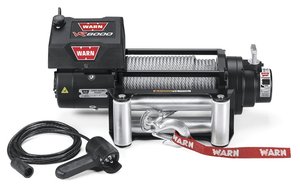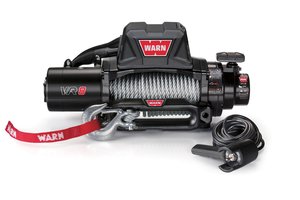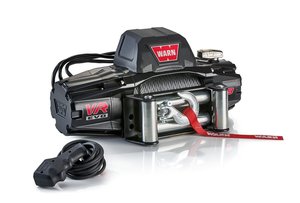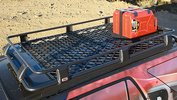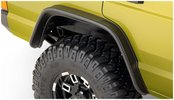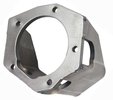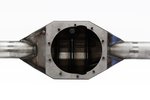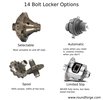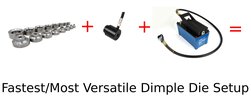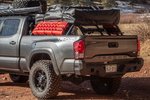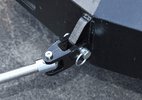Made in China Warn Winches: The Old VR vs. The New VR EVO
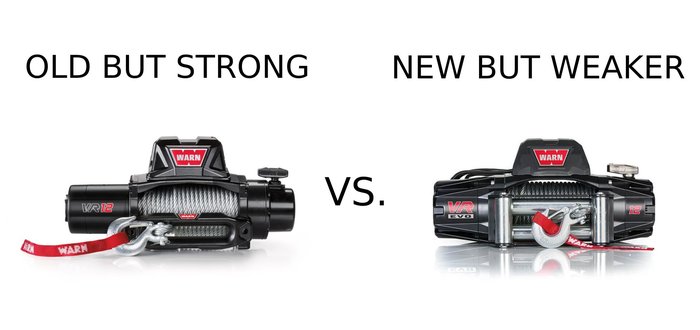
Looking for a Chinese Warn winch?
Warn has recently released it's new Warn VR EVO series of winches. This is the third generation of made-in-China Warn VR-series winches.
If you think you want to pick one of these up, read on to see what's different.
There are some...interesting...changes to the motor and gearing.
- Are Warn Winches Made in the USA?
- Warn VR10000-S Winch 87840: Full Specs and Data
- Warn VR10-S Winch 96815: Full Specs and Data
- Warn VR EVO 10-S Winch 103253: Full Specs and Data
- VR8000 Steel and VR8000-S Synthetic (1st Gen)
- VR8 Steel and VR8-S Synthetic (2nd Gen)
- VR EVO 8 Steel and VR EVO 8-S Synthetic (3rd Gen)
- VR10000 Steel and VR10000-S Synthetic (1st Gen)
- VR10 Steel and VR10-S Synthetic (2nd Gen)
- VR EVO 10 Steel and VR EVO 10-S Synthetic (3rd Gen)
- VR12000 Steel (1st Gen, no synthetic was available)
- VR12 Steel and VR12-S Synthetic (2nd Gen)
- VR EVO 12 Steel and VR EVO 12-S Synthetic (3rd Gen)
- the performance of the 8000, 10000, and 12000 lb winches in a particular generation
- the performance of the older VR winch generations vs. the new generation
- Use anchors that are far away. This gets cable off the drum and winch speed stays at the rated numbers.
- Use a snatch block. This gets cable off the drum, but it also halves your linespeed.
- Steel roller and polished aluminum fairleads
- 5 pin remote connector
- Solenoid control packs
- Not waterproof
- Spydura on the synthetic version
- The steel cable version came with a roller fairlead, not a cheaper steel hawse.
- The synthetic winch line version came with Warn's Spydura winch line and a polished aluminum fairlead. These features aren't seen on the later VRs.
- All of these winches came with solenoid control packs, not the later (and better!) Albright contactor packs.
- All of them use a 5 pin connector and came with a wired remote. Warn has a plug-in connector to make these winches wireless.
- VR8000: 8000 lb winch, steel winch line
- VR8000-S: 8000 lb winch, synthetic winch line
- VR10000: 10000 lb winch, steel winch line
- VR10000-S: 10000 lb winch, synthetic winch line
- VR12000: 12000 lb winch, steel winch line
- Steel hawse fairlead on all
- Same performance specs as 1st Gen
- Decreased weight
- Waterproof Albright contactor pack
- VR 8: 8000 lb winch, steel winch line
- VR 8-S: 8000 lb winch, synthetic winch line
- VR 10: 10000 lb winch, steel winch line
- VR 10-S: 10000 lb winch, synthetic winch line
- VR 12: 12000 lb winch, steel winch line
- VR 12-S: 12000 lb winch, synthetic winch line
- Steel roller/steel hawse fairleads
- Wired and wireless remotes
- Waterproof
- Less amp draw and slightly faster
- Less powerful than earlier versions
- VR EVO 8: 8000 lb winch, steel winch line
- VR EVO 8-S: 8000 lb winch, synthetic winch line
- VR EVO 10: 10000 lb winch, steel winch line
- VR EVO 10-S: 10000 lb winch, synthetic winch line
- VR EVO 12: 12000 lb winch, steel winch line
- VR EVO 12-S: 12000 lb winch, synthetic winch line
About Warn's VR Series
Warn has now released three generations of the VR-series of winch.
We're going to be comparing the winches in these weight classes:
8000 lb:
10000 lb:
12000 lb:
These winches are - gasp(!) - made in China.
This is not a terrible thing - it keeps Warn competitive with other manufacturers and they still employ hundreds of workers at their Clackamas, Oregon plant.
The VR line is fully made in China, while Warn's other winches are assembled in the USA (some of the USA winches have non-US parts but are heavily machined in the US).
If you're hoping to get Smittybilt prices from Warn, you won't!
Sorry!
The newest generations of the Warn VR probably outcompete Smittybilt on features and are likely a little better built. Warn likes to point out that the VR line is designed in the US and manufactured to their standards in China.
You should pay attention to that last line!
Just because something is made in China doesn't make it junk - companies that manufacture elsewhere are fully capable of dictating production standards.
That's why iPhones have great quality (Apple has high standards) and dollar stores sell junk (no one has high standards for dollar store merchandise).
How to Read the Performance Graphs
We're going to show graphs comparing all the winches in this article so you can see:
This is actually pretty interesting data, so we'll tell you what to look at in the graphs.
Amp Draw and Linespeed
Here's the weight-speed-amperage data for a 1st Gen Warn VR8000:

With a higher load, linespeed is decreased and amp draw is increased.
Let's break it down:
First, linespeed - this is how fast your winch line reels in while you're winching. In the graph, this is represented by the solid line. With no load on the the winch, linespeed is very high - almost 30 feet per minute.
As soon as we put a load on the winch, 2000 lbs in this graph, linespeed drops pretty quickly. This is very typical.
With increasing weight linespeed drops even more. At the fully rated load of 8000 lbs, the Warn VR8000 has about a tenth of the linespeed as it does without a load.
Next, amp draw:
The more weight you pull, the more electricity your winch will need from your electrical system.
This is also very clearly shown on the graph by the dotted line:
With no load, there is 0 amp draw.
As the winch experiences greater loads amp draw is increased. At the max load rating of 8000 lbs. the winch is pulling around 450 amps.
Amp draw is the reason that people like to upgrade their alternator or switch to a dual battery setup - it helps if you can recharge your battery more quickly or have more reserve capacity when you need to do a lot of winching.
Pulling Power per Layer of Winch Line - YOU NEED TO KNOW THIS!
If you want maximum pulling power out of your winch, you need to spool out as much winch line as possible.
If there's one thing that will help your winching, it's knowing about cable layers vs. pulling power!!
What's that even mean!?
Your winch line wraps onto the winch drum in layers.
Your winch is strongest when it has around one layer of cable on the drum. It's weakest when it has its max number of cable layers on the drum, usually four or five.
In other words, if you want maximum pulling power out of your winch, you need to spool out as much winch line as possible.
WARNING:
You need at least five wraps of winch line on your drum for safety! Part of the way your winch line is secured to the drum is just the friction of being on the drum.

With more layers of cable on the drum, pulling power is decreased.
If you take a look at the graph for the VR8000 it only pulls 8000 lbs of weight when it has 1 layer of winch line on the drum!
If you only spool out the winch line a few feet, it can only pull about 6200 lbs!
This is basically just a physics thing.
With lots of cable on the drum, the winch line is further away from the centerline of the drum, so it's more work for the motor to turn the drum. When the cable is closer, it's easier.
But how can you winch so that your winch is pulling near its full capacity?
You can do this in two ways:
Snatch blocks are also good when you need to do a full weight pull because they can keep your winch cable from snapping.
Warn VR, 1st Generation
Warn's first VR-series winches was a toe-dipping in the water. They've clearly been successful, because they just keep making them.
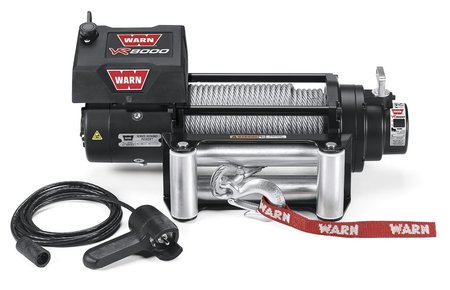
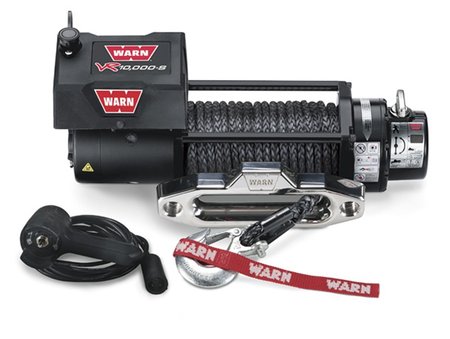
Quick Points
There were some prominent features that we thought we interesting:
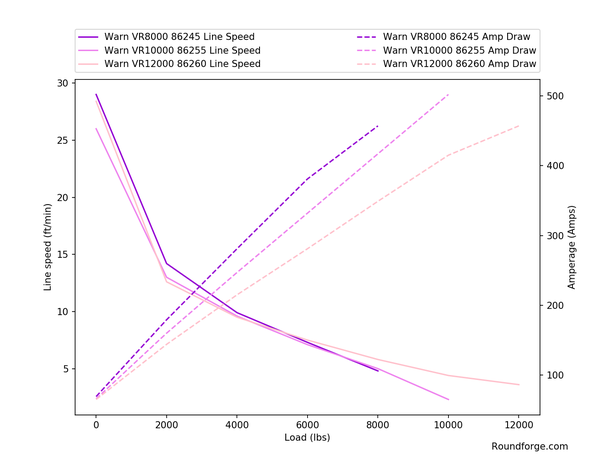
This is the first of 3 generations of the Warn VR winches.
The styling of these earlier winches wasn't too fancy - the control packs were just starting to get some styling to make them look tactical.
Each of these winches used the old-style tie rods between the motor and gearbox to tie the winch together. We don't have a preference for either, but later winches switched to a tie plate.

This is the first of 3 generations of the Warn VR winches
There were five winches in the VR line: (click the links to see stats, manuals, and parts lists for each)
This was the time of the beginning of synthetic winch line offerings, so Warn only offered the lighter-weight synthetic version for the 8,000 and 10,000 lb winches. This is indicated by the "-S" on the end of the model number.
Warn VR, 2nd Generation
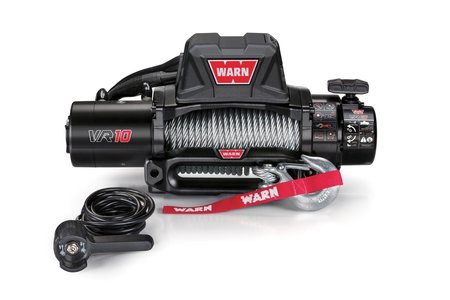
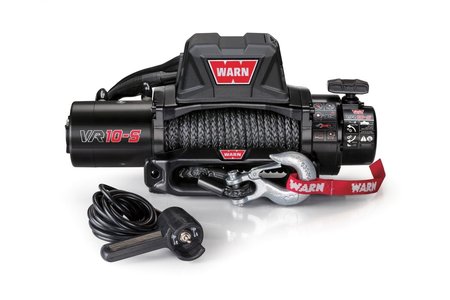
Quick Points
The second generation VR winches were similar in some ways, but very different in others.
Probably the most noticeable change is the new, sleek, tactical appearance. Instead of the tie rods that hold the cases together, this winch uses a tie plate that the control box rests on.
One big change is the fairleads: where the 1st Gens used a steel
roller fairlead or a polished aluminum hawse, the 2nd Gens all came with
a cast steel hawse.
Cast steel is fine for both steel winch line and synthetic, but the hawse will rust with steel lines once the powdercoat wears off. This fairlead definitely felt like a step back from the more traditional steel roller and aluminum hawse of the earlier version.
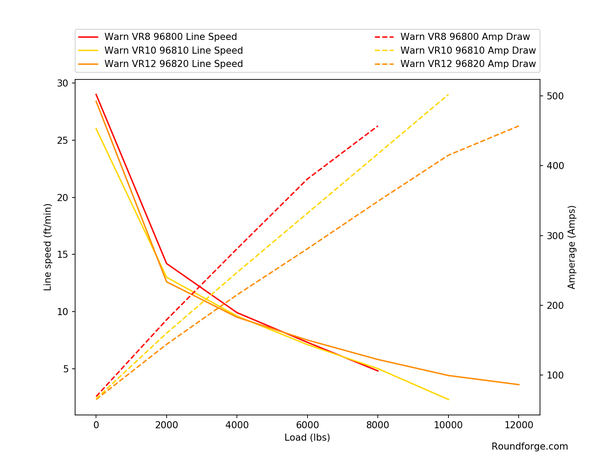
This is the second of 3 generations of the Warn VR winches. These numbers are exactly the same as the 1st Gen VR winches.
Want an awesome feature?
While the 1st Gens came
with solenoid control packs, these used a waterproof Albright contactor
pack. This was exciting because contactors have developed a reputation
for being more reliable than solenoids.
Plus, while it's always been easy to soak winch solenoids - they aren't sealed AT ALL - this control pack is completely waterproof.
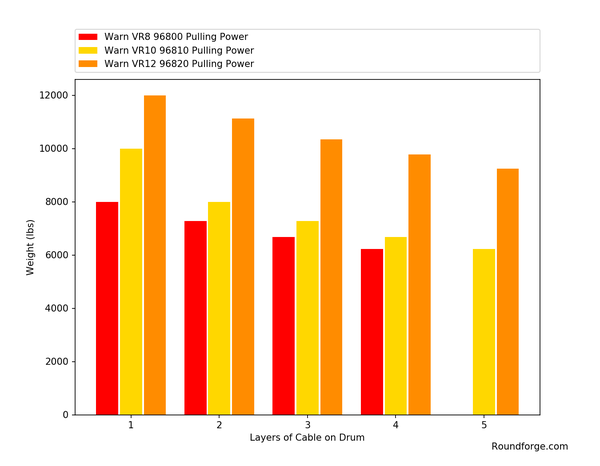
This is the second of 3 generations of the Warn VR winches. These numbers are exactly the same as the 1st Gen VR winches.
This generation of winches was probably the first budget winch to offer an Albright contactor pack.
Performance-wise, this generation performs exactly the same as the 1st Generation VR winch. The gear ratio, pull-by-layer data, amp draw, and line speed are all exactly the same.
There were six winches in the 2nd Gen VR line: (click the links to see stats, manuals, and parts lists for each)
This generation of VR winches also added a synthetic version for the 12000 lb winch. Like the 1st Gen, a synthetic version is indicated with a "-S"
We've included the graphs here, but note that they're exactly the same as the last set you looked at.
Warn VR EVO, 3rd Generation
There are some very interesting and significant changes with the 3rd generation of Warn's VR line.
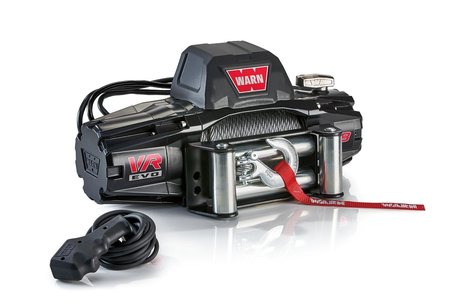
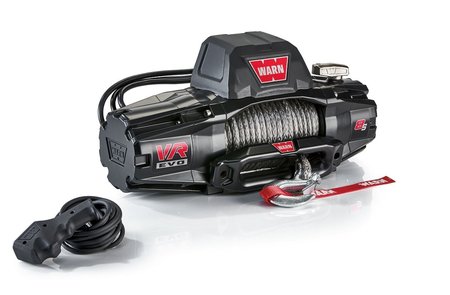
Quick Points
This generation has a slightly updated appearance - if the 2nd Gen VRs were sleek and tactical, this generation of winches is even moreso.
Warn also went back to a steel roller/hawse fairlead combo.
So:
If you get a VR EVO with a steel winch line, you get a steel roller fairlead (like the first Gen VR).
If you get a VR EVO with a synthetic winch line, you get a cast steel hawse fairlead (like the 2nd Gen VR).
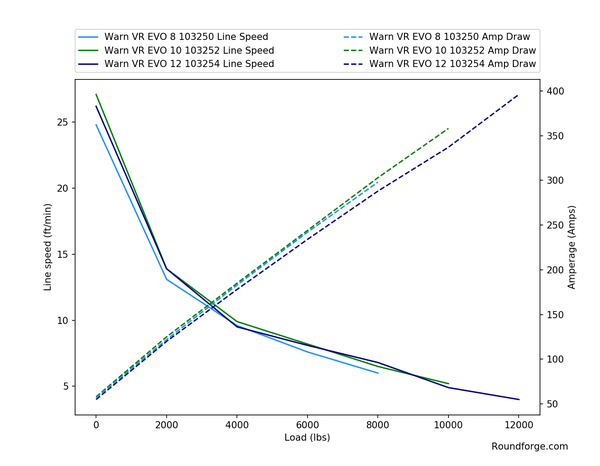
This is the third of 3 generations of the Warn VR winches
Warn not only kept the fancy waterproof Albright contactor pack, they've actually upgraded the controller to be wired and
wireless. This is the first generation of these winches to have a
wired/wireless remote and probably is a response to the very
budget-oriented Smittybilt XRC 9500 (and other winches in the XRC line) having a wired/wireless winch remote.

This is the third of 3 generations of the Warn VR winches
Another big change:
The
VR EVO line has an IP68 rating. This can actually mean various things,
but we'd expect that you can dunk this winch on a river crossing and not
have water enter the gearbox or motor.
This is not the case with other Warn winches like the M8, M10, M12, etc (although those are high-quality winches assembled in the US).
There are six winches in the VR EVO line: (click the links to see stats, manuals, and parts lists for each)
Like the 2nd Gens, this generation of VR winches has three steel cable winches and three synthetic line. Like the 1st Gen and 2nd Gen VRs, a synthetic version is indicated with a "-S"
The VR EVO Motor: The Big Bombshell!
Without a doubt, one of the most interesting things about the VR EVO line is that the motor and gearbox are different than the old versions.
We know this because the performance data is completely different.
The biggest differences are that the amp draw is lower for these winches across the board (sometimes very significantly) and the pulling power is decreased with each additional wrap of cable on the drum.
We're going to directly compare each generation of the VR winch line across weight classes below.
Old VR Performance vs. New VR EVO Performance - BIG CHANGES!
The old VR winches are markedly different from the newer ones. Let's take a look at the 8000 lb winches first.
8000 lb Winches: VR8000 vs. VR8 vs. VR EVO 8
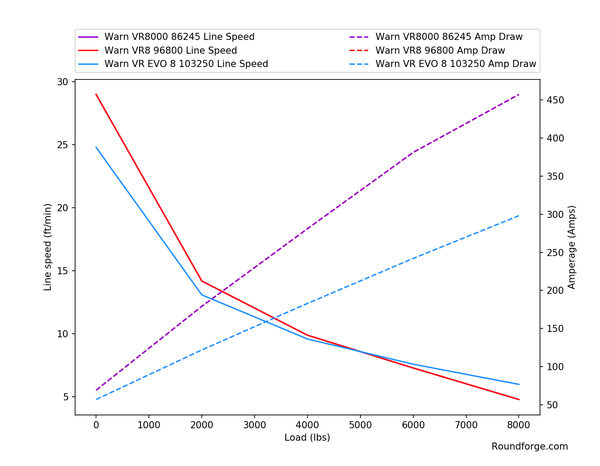
At low weights, the VR EVO 8 is a little slower than previous generations with low weights and a little faster at high weights. Amp draw has been significantly decreased in the VR EVO 8! (Note that the VR8000 and VR8 lines overlay each other on this graph because they're the same.)
First, note that the 1st and 2nd Gen winches have exactly the same performance characteristics, so they precisely overlap in this graph.
The VR EVO 8000 lb winches are slower with no load on the winch line, but are now almost twice as fast as previous VR generations at full load.
Our thought is that at lower loads, you won't notice too much difference between the old and the new, but at full load, it'll be pretty different.
Amp draw is also drastically reduced with the new EVOs. At full load, you can expect to be pulling around 150 amps less!
That's a pretty drastic decrease.

Note that with more layers of winch line on the drum, the VR EVO 8 is weaker than earlier versions.
This chart shows something even more important:
While the EVO winch is still capable of pulling 8000 lbs, its strength is significantly decreased.
Previous generations could pull about 6200 lbs with 4 cable layers on the drum.
The EVO version is down to about 5100 lbs, a drop of 1100 lbs!
10000 lb Winches: VR10000 vs. VR10 vs. VR EVO 10
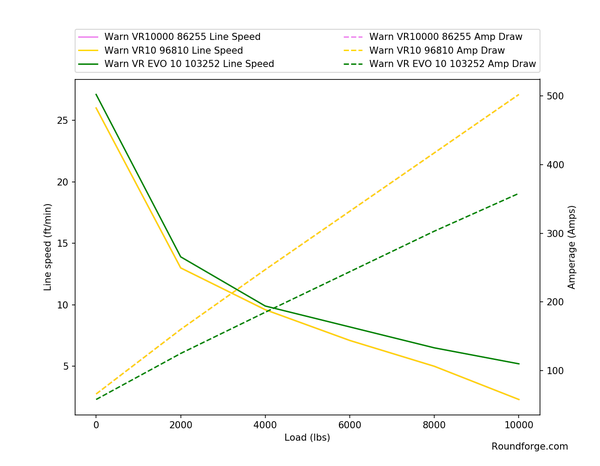
The VR EVO 10 10000 lb winch is faster than previous VRs 10000 lb. winches at all weights and significantly faster at maximum weight. The amp draw is also significantly compared to previous generations. (Note that the VR10000 and VR10 lines overlay each other on this graph because they're the same.)
First, note that the 1st and 2nd Gen winches have exactly the same performance characteristics, so they precisely overlap in this graph.
The newer EVO 10000 lb winch is faster at all loads than previous generations. In fact, at full load the line speed has more than doubled from 2.3 feet/minute for the 1st and 2nd Gens to 5.2 feet/minute for the EVO.
Like the 8000 lb winches, the amp draw is also significantly decreased.
At full load, the amp draw of a 10000 lb EVO is 144 amps less than the previous generations!

Note that with more layers of winch line on the drum, the VR EVO 10 is weaker than earlier versions.
Unfortunately, just like we saw with the 8000 lb winches, the 10000 lb EVO has significantly reduced pulling power compared to previous generations.
The pulling power decrease isn't as bad as with the 8000 lb winches:
The 1st and 2nd Gens pull 6230 lbs with 5 wraps on the drum and the EVO pulls 5370, a difference of 860 lbs - still quite a bit.
12000 lb Winches: VR12000 vs. VR12 vs. VR EVO 12 - LARGEST POWER DECREASE
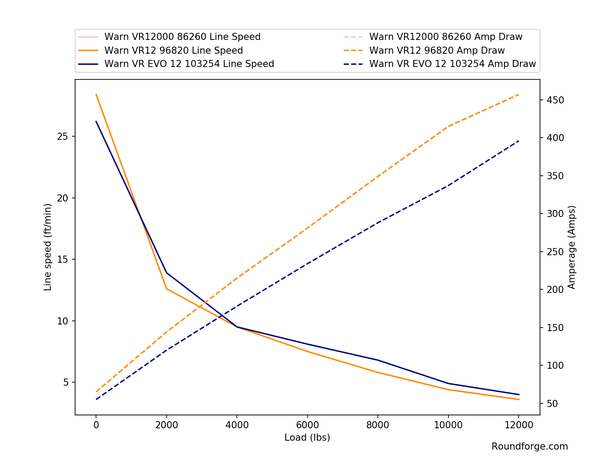
The VR EVO 12 12000 lb winch is slightly slower at with no load, but is a little faster than its predecessors in the VR winch line. Amp draw has also decreased, but not as significantly as with the 8000 and 10000 lb winches. (Note that the VR10000 and VR10 lines overlay eachother on this graph because they're the same.)
First, note that the 1st and 2nd Gen winches have exactly the same performance characteristics, so they precisely overlap in this graph.
Continuing the pattern, the 12000 lb EVO winches mostly faster than the previous generation (except at no load). But the speed differences with the EVO are pretty minimal compared to the 8000 and 10000 lb winches.
Similarly, the amp draw has been reduced, but not as much as with the 8000 and 10000 lb winches.
At max load, the VR EVO 12 is pulling 396 amps, which is 61 amps less than the VR 12 that pulled 457 amps. That motor needs to work extra hard for those extra lbs.

Note that with more layers of winch line on the drum, the VR EVO 12 is weaker than earlier VR versions.
WOW!
The VR EVO 12 has the largest decrease in pulling power out of all the EVO winches.
With 5 layers of cable on the drum the 1st and 2nd Gen VRs would pull 9250 lbs. With the current 12000 lb EVO, that's been decreased to 6324 lbs, a whopping 2900 lbs!!
In fact, a 1st/2nd Gen VR with 4 layers on the drum is about as strong (9770 lbs) as an EVO with 2 layers on the drum (9801 lb).
Honestly, this is not the performance we'd like to see from this winch.
If you have this winch, you'll really need to make sure that you're spooling out as much winch line as possible to maximize your pulling power.
A few thoughts on the performance differences
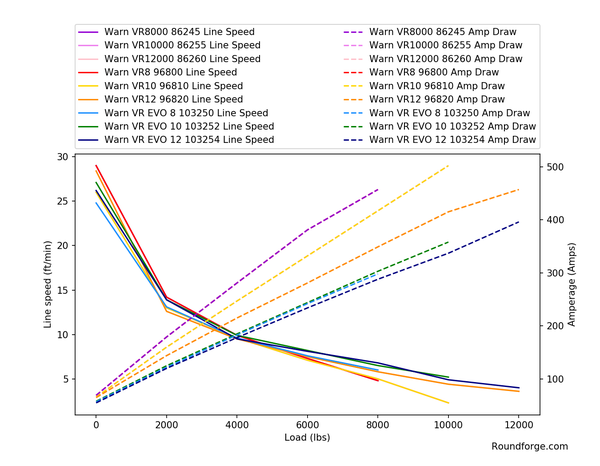
The EVOs are a little faster and have significantly less amp draw than the previous VRs.
We think that the slightly increased line speeds are good in the new EVO winches.
Also, it's great to see such a massive reduction in amp draw. The VR EVO line should put quite a bit less stress on your electrical system than previous generations.
While you might previously have considered a dual battery setup or more powerful alternator, this generation of EVOs probably won't require either for casual use.
However:
We can't ignore the massive power drops across the 8000, 10000, and 12000 lb weight classes.
The graph below makes it very clear that the VR EVO line has lost a lot of power compared to earlier models when you have a lot of line on the drum. In the graph, these are the Blue, Green, and Dark Blue bars.
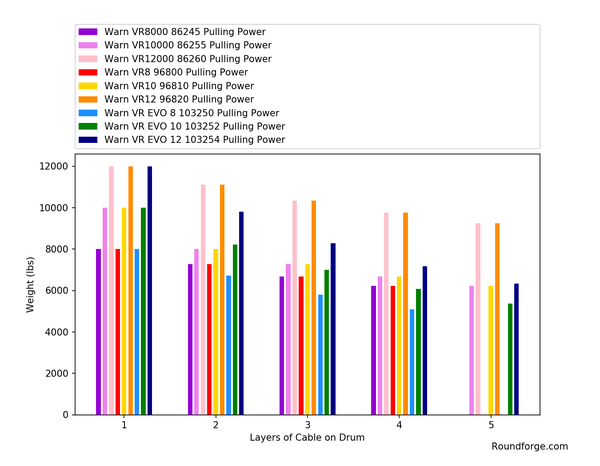
You can see a huge performance drop in the most recent VR winches when you have lots of cable on the drum.
Frankly, you're going to need to use a bit more care if you're going to push an EVO winch to its limits - make sure you spool out lots of winch line to get that cable off the drum.
That's the only way you can be sure that your EVO will be it's strongest.
Last updated: November 5, 2019
